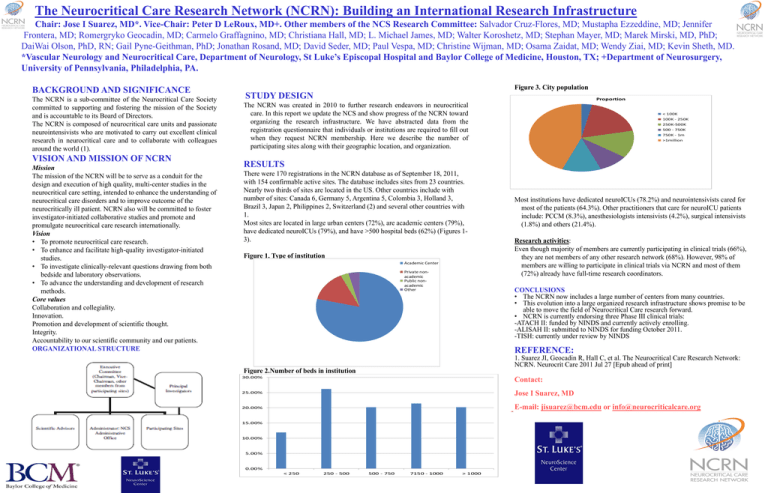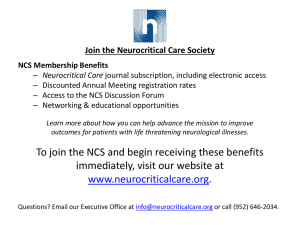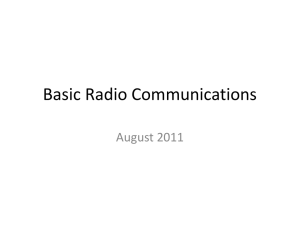Abstract presented at the NCS meeting in Montreal
advertisement

The Neurocritical Care Research Network (NCRN): Building an International Research Infrastructure Chair: Jose I Suarez, MD*. Vice-Chair: Peter D LeRoux, MD+. Other members of the NCS Research Committee: Salvador Cruz-Flores, MD; Mustapha Ezzeddine, MD; Jennifer Frontera, MD; Romergryko Geocadin, MD; Carmelo Graffagnino, MD; Christiana Hall, MD; L. Michael James, MD; Walter Koroshetz, MD; Stephan Mayer, MD; Marek Mirski, MD, PhD; DaiWai Olson, PhD, RN; Gail Pyne-Geithman, PhD; Jonathan Rosand, MD; David Seder, MD; Paul Vespa, MD; Christine Wijman, MD; Osama Zaidat, MD; Wendy Ziai, MD; Kevin Sheth, MD. *Vascular Neurology and Neurocritical Care, Department of Neurology, St Luke’s Episcopal Hospital and Baylor College of Medicine, Houston, TX; +Department of Neurosurgery, University of Pennsylvania, Philadelphia, PA. BACKGROUND AND SIGNIFICANCE The NCRN is a sub-committee of the Neurocritical Care Society committed to supporting and fostering the mission of the Society and is accountable to its Board of Directors. The NCRN is composed of neurocritical care units and passionate neurointensivists who are motivated to carry out excellent clinical research in neurocritical care and to collaborate with colleagues around the world (1). VISION AND MISSION OF NCRN Mission The mission of the NCRN will be to serve as a conduit for the design and execution of high quality, multi-center studies in the neurocritical care setting, intended to enhance the understanding of neurocritical care disorders and to improve outcome of the neurocritically ill patient. NCRN also will be committed to foster investigator-initiated collaborative studies and promote and promulgate neurocritical care research internationally. Vision • To promote neurocritical care research. • To enhance and facilitate high-quality investigator-initiated studies. • To investigate clinically-relevant questions drawing from both bedside and laboratory observations. • To advance the understanding and development of research methods. Core values Collaboration and collegiality. Innovation. Promotion and development of scientific thought. Integrity. Accountability to our scientific community and our patients. ORGANIZATIONAL STRUCTURE Figure 3. City population STUDY DESIGN Proportion The NCRN was created in 2010 to further research endeavors in neurocritical care. In this report we update the NCS and show progress of the NCRN toward organizing the research infrastructure. We have abstracted data from the registration questionnaire that individuals or institutions are required to fill out when they request NCRN membership. Here we describe the number of participating sites along with their geographic location, and organization. < 100K 100K - 250K 250K-500K 500 - 750K 750K - 1m >1million RESULTS There were 170 registrations in the NCRN database as of September 18, 2011, with 154 confirmable active sites. The database includes sites from 23 countries. Nearly two thirds of sites are located in the US. Other countries include with number of sites: Canada 6, Germany 5, Argentina 5, Colombia 3, Holland 3, Brazil 3, Japan 2, Philippines 2, Switzerland (2) and several other countries with 1. Most sites are located in large urban centers (72%), are academic centers (79%), have dedicated neuroICUs (79%), and have >500 hospital beds (62%) (Figures 13). Most institutions have dedicated neuroICUs (78.2%) and neurointensivists cared for most of the patients (64.3%). Other practitioners that care for neuroICU patients include: PCCM (8.3%), anesthesiologists intensivists (4.2%), surgical intensivists (1.8%) and others (21.4%). Research activities: Even though majority of members are currently participating in clinical trials (66%), they are not members of any other research network (68%). However, 98% of members are willing to participate in clinical trials via NCRN and most of them (72%) already have full-time research coordinators. Figure 1. Type of institution Academic Center Private nonacademic Public nonacademic Other CONCLUSIONS • The NCRN now includes a large number of centers from many countries. • This evolution into a large organized research infrastructure shows promise to be able to move the field of Neurocritical Care research forward. • NCRN is currently endorsing three Phase III clinical trials: -ATACH II: funded by NINDS and currently actively enrolling. -ALISAH II: submitted to NINDS for funding October 2011. -TISH: currently under review by NINDS REFERENCE: 1. Suarez JI, Geocadin R, Hall C, et al. The Neurocritical Care Research Network: NCRN. Neurocrit Care 2011 Jul 27 [Epub ahead of print] Figure 2.Number of beds in institution 30.00% Contact: 25.00% Jose I Suarez, MD 20.00% E-mail: jisuarez@bcm.edu or info@neurocriticalcare.org - 15.00% 10.00% 5.00% 0.00% < 250 250 - 500 500 - 750 7150 - 1000 > 1000










